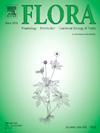Leaf traits mediate galling insect frequency on woody plants in a Neotropical savanna
IF 1.8
4区 生物学
Q3 ECOLOGY
引用次数: 0
Abstract
Galling insects are highly specialized herbivores that exhibit intimate interactions with their host plants. However, the role of interspecific variation in plant traits on galling species occurrence has been little explored. Here, we assessed the roles of nutritional (P:N ratio) and defensive (latex, specific leaf area, leaf toughness and extrafloral nectaries) leaf traits in determining galling insect frequency and richness across 50 woody plant species in a Brazilian savanna. Specifically, we tested the hypotheses that nutritional leaf traits attract galling insects, thus increasing their frequency and species richness, while defensive leaf traits reduce galling frequency and richness. Sampling was conducted during the rainy season, resulting in the identification of 82 galling insect species distributed among 42 plant species. We found no relationship between leaf traits and galling species richness. However, latex reduced the frequency of galling insects, whereas the presence of extrafloral nectaries, tougher leaves and higher leaf P:N ratio were positively associated with galling frequency. Our findings indicate that latex plays an important role on the occurrence of galling insects, presumably by hindering oviposition and reducing egg survival and larval hatching. Additionally, the presence of extrafloral nectaries may offer protection against natural enemies, tough leaves can increase leaf longevity and enhance defense against herbivory, and galling species prefer plant with better nutritional quality. In contrast to previous studies, we demonstrate that defensive and nutritional leaf traits do not affect galling species richness; rather, defensive traits influence the frequency of galling insects among savanna plant species.
新热带热带稀树草原木本植物的叶片性状调节了害虫的频率
昆虫是高度专业化的食草动物,它们与寄主植物表现出亲密的相互作用。然而,植物性状的种间变异对瘿虫发生的影响研究甚少。在此,我们评估了营养(P:N比)和防御(乳胶、比叶面积、叶韧性和花外蜜腺)叶片性状在决定巴西热带稀树草原50种木本植物的瘿虫频率和丰富度中的作用。具体而言,我们验证了营养叶片性状吸引骚扰昆虫,从而增加其频率和物种丰富度,而防御性叶片性状减少骚扰频率和丰富度的假设。在雨季取样,鉴定出82种昆虫,分布在42种植物中。结果表明,叶片性状与刺槐物种丰富度之间没有相关性。然而,乳胶降低了剥落昆虫的频率,而花外蜜腺、更坚韧的叶片和更高的叶片磷氮比与剥落频率呈正相关。我们的研究结果表明,乳胶在骚扰昆虫的发生中起着重要的作用,可能是通过阻碍产卵,降低卵的存活率和幼虫的孵化。此外,花外蜜腺的存在可以提供对天敌的保护,坚韧的叶子可以延长叶子的寿命,增强对食草动物的防御能力,并且刺痛物种更喜欢营养质量更好的植物。与以往的研究相比,我们发现防御性和营养性叶片性状不影响食饵物种的丰富度;相反,防御性性状影响了热带草原植物物种中骚扰昆虫的频率。
本文章由计算机程序翻译,如有差异,请以英文原文为准。
求助全文
约1分钟内获得全文
求助全文
来源期刊

Flora
生物-植物科学
CiteScore
3.30
自引率
10.50%
发文量
130
审稿时长
54 days
期刊介绍:
FLORA publishes original contributions and review articles on plant structure (morphology and anatomy), plant distribution (incl. phylogeography) and plant functional ecology (ecophysiology, population ecology and population genetics, organismic interactions, community ecology, ecosystem ecology). Manuscripts (both original and review articles) on a single topic can be compiled in Special Issues, for which suggestions are welcome.
FLORA, the scientific botanical journal with the longest uninterrupted publication sequence (since 1818), considers manuscripts in the above areas which appeal a broad scientific and international readership. Manuscripts focused on floristics and vegetation science will only be considered if they exceed the pure descriptive approach and have relevance for interpreting plant morphology, distribution or ecology. Manuscripts whose content is restricted to purely systematic and nomenclature matters, to geobotanical aspects of only local interest, to pure applications in agri-, horti- or silviculture and pharmacology, and experimental studies dealing exclusively with investigations at the cellular and subcellular level will not be accepted. Manuscripts dealing with comparative and evolutionary aspects of morphology, anatomy and development are welcome.
 求助内容:
求助内容: 应助结果提醒方式:
应助结果提醒方式:


